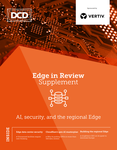The rapid advancement of AI in 2023 saw many industries and government regulations scrambling to keep pace. In many ways, AI has become a double-edged sword for the data center industry.
The increased workloads driven by AI usage will undoubtedly contribute to the growth of the sector and further emphasize its critical nature; however, this will place significant added strain on an industry that is already grappling to keep pace with unprecedented demand and the availability of power and land becomes an increasing challenge.
In other words, as the demand for AI increases, so does the need for data centers to adapt to the challenges posed by this technological revolution.
Accelerating AI adoption calls for more storage capacity
As AI workloads grow in size and complexity, the need for data storage increases exponentially. As it relates to ChatGPT alone, a recent Wired article discussed how an AI search compared in compute power to traditional search, noting that at least four or five times more is required per search. At scale, this is a significant uplift, “particularly when AIs are eventually trained on current data and not merely datasets from a snapshot in time.”
In light of this, the industry is only just beginning to understand the resulting impact this will have on data centers. In fact, the growth of AI is largely, if not wholly, dependent upon the ability of data centers and power infrastructures to meet this demand by collaborating on finding new sustainable compromises to pursue innovation without causing more emissions and energy consumption.
So what does this mean for the data center industry in 2024 and beyond?
Undoubtedly the acceleration of AI is currently being driven from the US, with massive training models being housed predominantly in this market. However, it is likely that we will start to see a shift to Europe, driven by a variety of factors.
Firstly, a bulk of the growth of AI in Europe will be driven by inference, the early decision-making phases in an AI system where predictions are made from processed data, meaning that demand will be more localized and distributed in the European market. This will inevitably require a lot of additional compute which the region will need to address and solve for in the coming year, including most critically, where these campuses will be deployed to meet the demand.
If it follows the US path, the deployment will happen in or close to a major metro environment, which will be a major shift for both the industry and wider society. To this date, we have seen an increasing number of cloud providers integrating these initial processing stages of AI workloads into their current capacity within traditional availability zones (AZs) to maximize the use of existing infrastructure. We believe this will be an ongoing priority in 2024 whilst they seek to better understand future needs.
The anticipated impact of data localization laws
The second factor driving the migration of training models from the US to Europe is data localization laws. Data localization requirements are typically regulatory mandates that enforce the storage and processing of data within the country or region it was created. This legislation has been anticipated for some time. However, the rapid acceleration of AI and its impact on data centers was not previously accounted for in any meaningful way.
If new data localization regulation shifts, requiring data to be processed in the local region or market, the industry will need to evaluate how it will accommodate it. Currently, there isn’t the power infrastructure in Europe to support training models of this size so it will either need to reinforce existing locations, move to new locations clustered around where there is power, or develop new technology that will reduce latency to make this feasible.
Given these factors, it’s likely we will start to see training models located in Europe at scale; however, it’s unlikely to match the size of the US models and will continue to be dependent on this market in the near term.
In light of this and the expected increase in demand, data centers’ customers must plan to secure their AI future in 2024 as a priority. We’re at a crossroads, with many hurdles and opportunities facing the industry as we know it, and the conversations and actions taking place today are ultimately shaping the data center industry of tomorrow.
This will require a continued evolution of the relationships customers have with their data center providers, working together to ensure alignment on priority markets, and evolutions in compute and processor performance. For example, ‘creativity’ and ‘data centers’ are not words you would naturally expect to see in the same sentence, but it has now been a notable outcome of how the industry needs to operate and ensure customers' needs are met.
As AI confirms its predominant role in the data center industry, the impact of issues including data storage, localization, and customer relations will continue to emerge, alongside the need for more regulations that support these new applications. Overall, 2024 promises an exciting year for the industry, where we’ll see more evidence of how advanced AI, computing, and other emerging technologies will shape the next generation of data centers.





